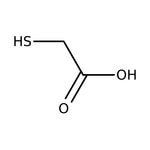Search Thermo Fisher Scientific
Acide thioglycolique 98 %, Thermo Scientific Chemicals



Acide thioglycolique 98 %, Thermo Scientific Chemicals
Identifiants chimiques
Spécifications
Description
This Thermo Scientific Chemicals brand product was originally part of the Alfa Aesar product portfolio. Some documentation and label information may refer to the legacy brand. The original Alfa Aesar product / item code or SKU reference has not changed as a part of the brand transition to Thermo Scientific Chemicals.
Réactif qui protège le tryptophane dans l’analyse des acides aminés. L’acide mercaptoacétique est utilisé comme agent de protection pour le tryptophane dans l’analyse des acides aminés et comme indicateur d’acidité. Il est utilisé comme intermédiaire dans les réactions chimiques telles que l’ajout, l’élimination et la cyclisation. Il agit comme précurseur du thioglycolate d’ammonium, du thioglycolate de sodium et du thioglycolate de calcium. Ses dérivés organostanniques sont utilisés comme stabilisants pour le chlorure de polyvinyle (PVC). En synthèse organique, il agit comme un nucléophile dans les réactions de thioglycolyse et comme agent de transfert de soufre pour la synthèse du chlorure de sulfonyle. De plus, il est utilisé dans le traitement du cuir.
Solubilité
Miscible à l’eau, l’éthanol, aux éthers, aux cétones, aux esters, aux hydrocarbures chlorés, au benzène et aux hydrocarbures aromatiques. Légèrement miscible au chloroforme.
Remarques
Sensible à l’air. Incompatible avec les agents oxydants forts et les acides forts.
Figures
Documentation et téléchargements
Certificats
Foire aux questions (FAQ)
Citations et références
Sécurité et manipulation
Classification of the substance or mixture
CLP classification - Regulation(EC) No 1272/2008
Label Elements
Signal Word
Danger
Hazard Statements
H301 + H311 - Toxic if swallowed or in contact with skin
H314 - Causes severe skin burns and eye damage
H317 - May cause an allergic skin reaction
H332 - Harmful if inhaled
Precautionary Statements
P280 - Wear protective gloves/protective clothing/eye protection/face protection
P301 + P330 + P331 - IF SWALLOWED: Rinse mouth. Do NOT induce vomiting
P303 + P361 + P353 - IF ON SKIN (or hair): Take off immediately all contaminated clothing. Rinse skin with water or shower
P304 + P340 - IF INHALED: Remove person to fresh air and keep comfortable for breathing
P305 + P351 + P338 - IF IN EYES: Rinse cautiously with water for several minutes. Remove contact lenses, if present and easy to do. Continue rinsing
P310 - Immediately call a POISON CENTER or doctor/physician